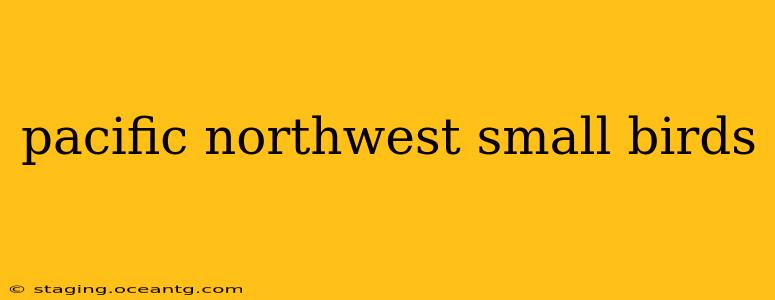The Pacific Northwest, with its diverse habitats ranging from lush rainforests to alpine meadows, is home to a vibrant array of small bird species. Identifying these feathered friends can be a rewarding hobby, and this guide will help you navigate the fascinating world of small birds in this region. We'll cover common species, key identification features, and answer some frequently asked questions.
What are some of the most common small birds in the Pacific Northwest?
Several small bird species are incredibly common throughout the Pacific Northwest. These include:
- Anna's Hummingbird: Easily recognizable by its iridescent gorget (throat patch) and aggressive nature.
- Rufous Hummingbird: A smaller, more vibrant hummingbird that migrates through the region.
- Downy Woodpecker: The smallest woodpecker in the region, with a distinctive black and white pattern.
- Northern Flicker: While slightly larger than other small birds on this list, it's frequently spotted and exhibits unique behaviors.
- House Wren: A tiny, energetic bird with a loud song, often found nesting in birdhouses or crevices.
- Song Sparrow: A ubiquitous brown bird with distinctive streaking and a beautiful, varied song.
- Junco: Several Junco species are found in the PNW, exhibiting subtle differences in plumage. They're often found on the ground foraging.
- Chickadee: Black-capped Chickadees are very common and easily identified by their "chick-a-dee-dee-dee" call.
What are the best places to see small birds in the Pacific Northwest?
The best places to spot small birds vary depending on the species and time of year, but some excellent locations include:
- National Parks and Forests: Olympic National Park, Mount Rainier National Park, and Gifford Pinchot National Forest offer diverse habitats and abundant birdlife.
- Wildlife Refuges: These protected areas often have high concentrations of birds, particularly migratory species.
- Urban Parks and Gardens: Even in cities, you can find many small birds visiting feeders and foraging in green spaces.
- Coastal Areas: Look for seabirds and shorebirds along the Pacific coastline.
How can I identify small birds in the Pacific Northwest?
Identifying small birds requires careful observation. Pay attention to these key features:
- Size and Shape: Compare the bird's size to familiar objects (e.g., your hand). Note its overall shape (slender, stout, etc.).
- Plumage: Observe the bird's color, patterns, and markings. Are the colors vibrant or muted? Are there any stripes, spots, or patches?
- Behavior: What is the bird doing? Is it foraging on the ground, hopping among branches, or hovering near flowers?
- Song and Calls: Listen carefully to the bird's vocalizations. Many species have distinctive songs and calls that aid in identification.
- Habitat: Where did you see the bird? Different species prefer different habitats.
What are some common mistakes people make when identifying small birds?
A common mistake is relying solely on color. Many bird species exhibit variations in plumage due to age, sex, and season. Combining color with other identifying characteristics, such as shape, size, and behavior, is crucial for accurate identification.
What resources are available for identifying Pacific Northwest small birds?
Several excellent resources can assist with bird identification:
- Field Guides: Many comprehensive field guides are available specifically for the Pacific Northwest.
- Bird Identification Apps: Numerous apps use image recognition technology to help identify birds based on photographs.
- Online Resources: Websites and online communities dedicated to birding offer valuable information and resources.
- Local Audubon Societies: These groups often organize bird walks and offer identification workshops.
Are there any small birds that are endangered or threatened in the Pacific Northwest?
Yes, some small bird populations in the Pacific Northwest face threats from habitat loss, climate change, and other factors. It's important to support conservation efforts to protect these vulnerable species. Specific species at risk can vary; consult local conservation organizations for updated information.
By combining careful observation with the resources mentioned above, you can greatly improve your ability to identify the diverse small birds that inhabit the beautiful Pacific Northwest. Happy birding!
